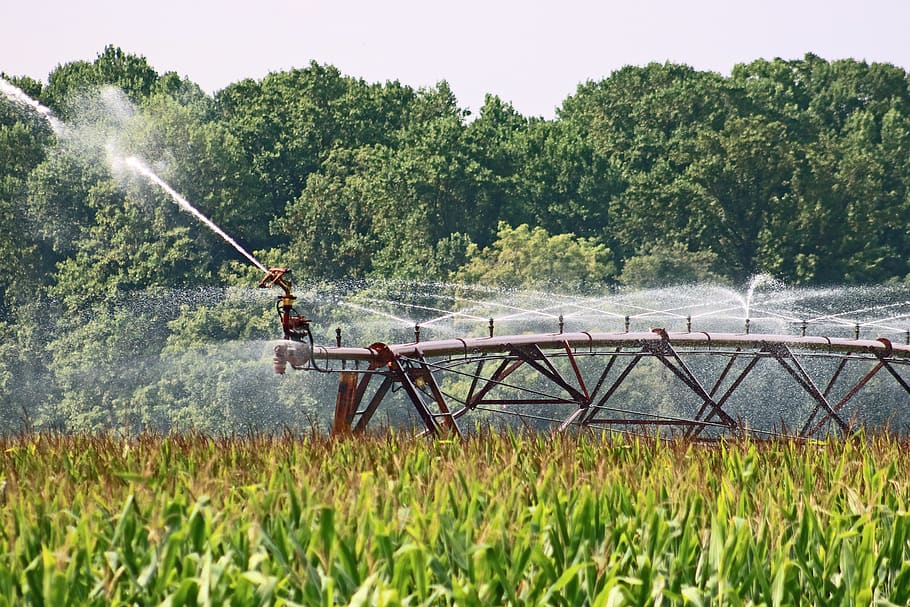Irrigation
Contents |
[edit] Introduction
Irrigation is the controlled watering of land by artificial means. It is primarily used to sustain crop growth, cool livestock, suppress weeds or protect land from freezing. It can also be used as a control measure in areas where lack of consistent water supply can have a negative impact on the landscape.
Irrigation has also been used for non-agricultural purposes such as sewage disposal and dust suppression.
[edit] History
As an agricultural tool, irrigation has been used around the world for thousands of years. The earliest evidence of its existence was found in Iran; this system is believed to date from 6000 BC.
In Egypt, significant irrigation measures were built around 3000 BC to control the level of the Nile. In addition to supplying water to crops, this irrigation project also involved the construction of other complex water engineering measures.
Irrigation was used extensively in ancient civilisations in China, India, Sri Lanka, Korea and the Americas.
[edit] Types of irrigation
There are several methods of irrigation, which vary in how the water is supplied. Some of the most common types include:
- Surface irrigation (also known as gravity irrigation).
- Micro-irrigation (also referred to as localised irrigation, low volume irrigation, trickle irrigation or drip irrigation).
- Sprinkler irrigation (also referred to as overhead irrigation).
- Subirrigation (or subsurface irrigation).
There are several water sources that can be used for irrigation purposes. These include:
- Groundwater (from springs or taken from wells).
- Surface water (taken from rivers, lakes or reservoirs).
- Treated water (including wastewater, desalinated water or drainage water).
- Floodwater harvesting (referred to as spate irrigation) or fog collection.
[edit] Related articles on Designing Buildings Wiki
Featured articles and news
RTPI leader to become new CIOB Chief Executive Officer
Dr Victoria Hills MRTPI, FICE to take over after Caroline Gumble’s departure.
Social and affordable housing, a long term plan for delivery
The “Delivering a Decade of Renewal for Social and Affordable Housing” strategy sets out future path.
A change to adoptive architecture
Effects of global weather warming on architectural detailing, material choice and human interaction.
The proposed publicly owned and backed subsidiary of Homes England, to facilitate new homes.
How big is the problem and what can we do to mitigate the effects?
Overheating guidance and tools for building designers
A number of cool guides to help with the heat.
The UK's Modern Industrial Strategy: A 10 year plan
Previous consultation criticism, current key elements and general support with some persisting reservations.
Building Safety Regulator reforms
New roles, new staff and a new fast track service pave the way for a single construction regulator.
Architectural Technologist CPDs and Communications
CIAT CPD… and how you can do it!
Cooling centres and cool spaces
Managing extreme heat in cities by directing the public to places for heat stress relief and water sources.
Winter gardens: A brief history and warm variations
Extending the season with glass in different forms and terms.
Restoring Great Yarmouth's Winter Gardens
Transforming one of the least sustainable constructions imaginable.
Construction Skills Mission Board launch sector drive
Newly formed government and industry collaboration set strategy for recruiting an additional 100,000 construction workers a year.
New Architects Code comes into effect in September 2025
ARB Architects Code of Conduct and Practice available with ongoing consultation regarding guidance.
Welsh Skills Body (Medr) launches ambitious plan
The new skills body brings together funding and regulation of tertiary education and research for the devolved nation.
Paul Gandy FCIOB announced as next CIOB President
Former Tilbury Douglas CEO takes helm.
UK Infrastructure: A 10 Year Strategy. In brief with reactions
With the National Infrastructure and Service Transformation Authority (NISTA).























